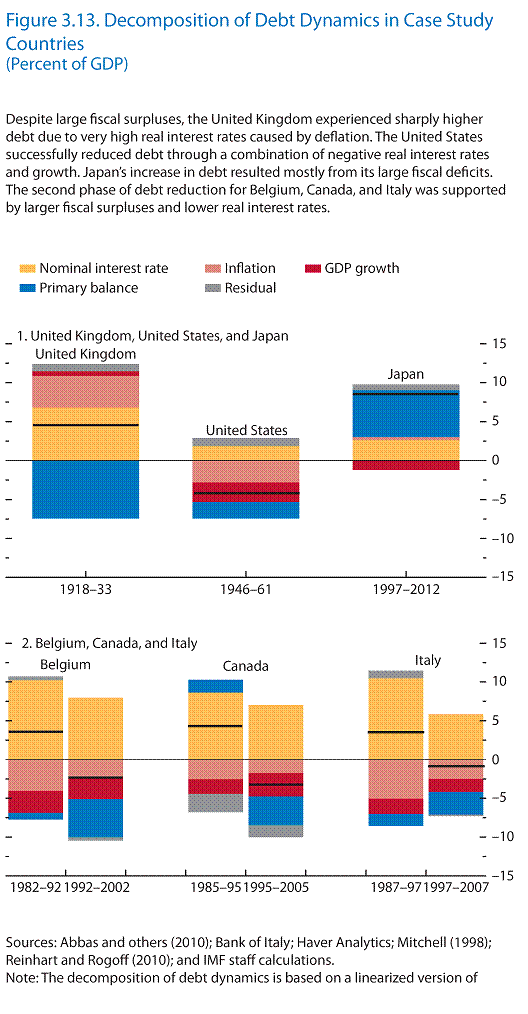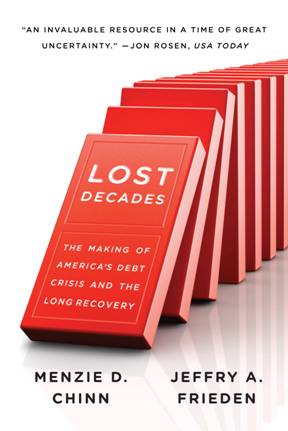The paperback edition of Lost Decades is officially released as of today.
As I noted last week, a lost of disinformation regarding the nature of recoveries from balance sheet/debt recessions has been circulated. [0] One is that adjustment can be accomplished by austerity and tight money. Chapter 3 of the IMF’s newly released World Economic Outlook suggests otherwise.
Figure 3-13 in particular illustrates the hazards of deflation in terms of making the public debt dynamics more challenging.

Figure 3.13 from IMF WEO, Ch. 3.
The summary notes:
…First, successful debt reduction
requires fiscal consolidation and a policy mix
that supports growth. Key elements of this policy mix
are measures that address structural weaknesses in the
economy and supportive monetary policy. Second, fiscal
consolidation must emphasize persistent, structural
reforms to public finances over temporary or short-lived
fiscal measures. In this respect, fiscal institutions can
help lock in any gains. Third, reducing public debt
takes time, especially in the context of a weak external
environment.
I would certainly agree that merely slapping on caps on spending levels, and voucherizing entitlements, is unlikely to be a credible path to debt stabilization.
The authors note the special aspects of the US debt decline in the post-WW II period. We have argued that a more expansionary monetary policy which leads to slightly higher inflation is an essential component to adjustment — not only because it will erode real public debt [1] [2], but because it will facilitate relative wage and price adjustment.[3]
Jeffry Frieden has elaborated on the challenges we outlined in “Lost Decades” in a recent Bernard Schwartz Lecture on the global debt crisis at Johns Hopkins University School for Advanced Studies.

We got out of WWII debt with a combination of inflation and budget surpluses.
It’s going to take a hell of a lot of inflation to overcome the 8% GDP deficits we’re running this time.
In exactly what years did the US have large budget surpluses in the port WW II era?
When I look at the data I only see one year of large surpluses –1948.
Otherwise it looks like a very long period of small imbalances during a period of strong nominal growth where the growth was the dominate reason the debt fell as a share of GDP.
hope you at lest mentioned writedowns and taking losses the distinquishing feature of the latest crisis is the refusal to do much of that..
How come there is only a Chapter 3 and Chapter 4 in this WEO? What happened to 1 y 2?
spencer: Be not surprised; W.C. Varones is untroubled by things such as data.
AWH: I don’t know about the comparisons to previous crises, but there were substantial writedowns by banks. See e.g. IMF, 2010, Global Financial Stability Report (Washington, DC: October), Figure 1.12.
mister f: Outlook chapters 1 and 2 of the WEO are typically released after the analytical chapters (3 and 4).
Menzie, be respectful to W.C. Varones.
Johannes: Jawohl!
I will seek to emulate you, in your careful and considered assessment of global climate change from a NOAA climate scientist (4/10/2012, 7:41AM), to wit:
Geez.
spencer,
I didn’t say “large surpluses.” I said “surpluses.” The total budget surpluses were fairly small (a few percent of GDP for a few years), but of course the primary surpluses were somewhat larger. And both of them were obviously FAR from our current 8% deficits.
Which again raises the question, how much inflation is it going to take to stabilize or reverse the trend of the debt/GDP ratio if we continue running large deficits?